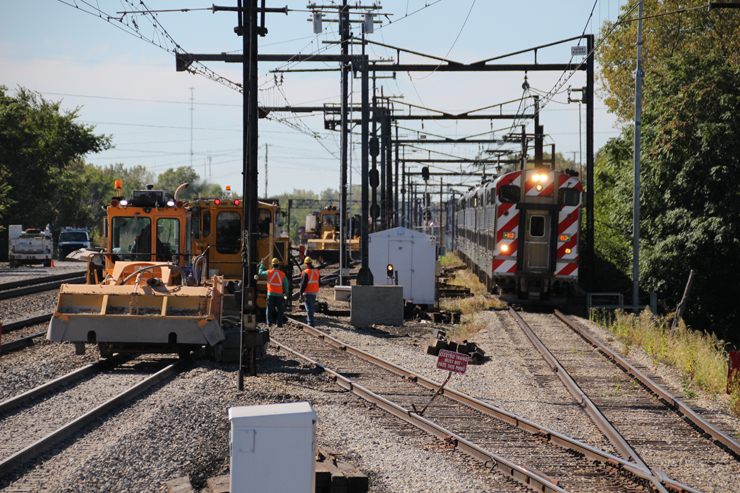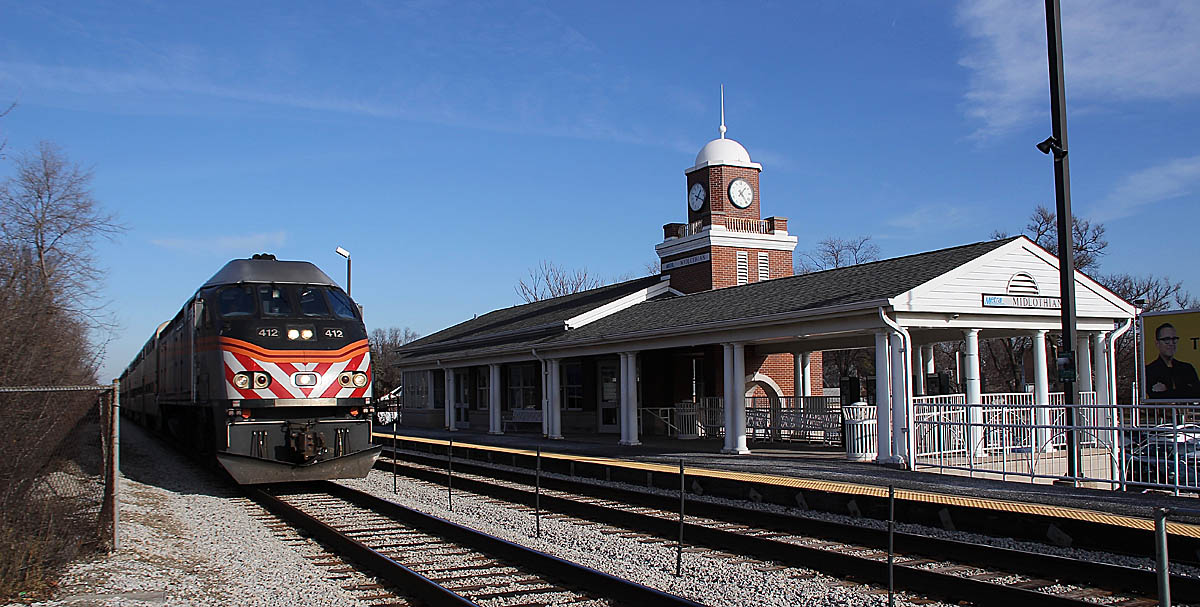But if that changes, the Chicago-area commuter rail system has a plan.
As part of his presentation Monday at the National Railroad Construction and Maintenance Association Conference, Chief Operating Officer and Deputy Executive Director Bruce Marcheschi not only outlined Metra’s capital plans for 2019, but the far greater vision that would come with a $5-billion, 10-year capital funding plan it is seeking from the state of Illinois.
Marcheschi called this “The Ask,” and it’s a big one – not only because of the dollar figure involved, but also because he noted it has been 10 years there was a state plan covering Metra capital needs. With a new governor, J.B. Pritzker, taking office on Wednesday, Marcheschi and Metra hope that might change.
“We’re hoping transportation for the region, and the state in general, might get a good capital bill,” he said. “… There’s a lot of things we need to do.”
What does “The Ask” entail?
- Rolling Stock: 40 new locomotives, 400 new coaches, and conversion of 54 existing locomotives to A.C. traction motors. Some of Metra’s coaches, for example, date to the 1950s. “We’re putting an RFP [Request For Proposal] together to go onto the street sometime in this first quarter, looking at at least 400 coach car purchases,” Marcheschi said.
- Station improvements: More warming shelters, with improved lighting and security cameras. “The station is really the first place our passengers get our experience,” Marcheschi said. “Is it clean? Is it safe? Am I well-guided? Do I know where I’m going? If we can’t get that first, then we miss the first step of the whole customer service program that we want.
- Service improvements: More express trains, which requires more capacity – not just in terms of cars, but yard space for those car, along with track improvements to run at higher speeds, more crossovers for dispatching flexibility, and extended platforms to accommodate longer trains.
- Refurbishment or replacement of 10 bridges a year – which still would address just a fraction of the more than 400 bridges Metra uses that are a century old or older.
- Electrification of the Rock Island District, the 40-mile route between downtown Chicago’s La Salle Street Station and Joliet, Ill. The Metra-owned line currently sees 67 trains each weekday. “We feel electrification is more reliable, it’s more efficient, and it reduces emissions. So that’s something that we’re looking at.”
- Replacement of the complex junction at Tower A-2, two miles from Chicago Union Station. “Seven lines of train service traverse it every day; 337 train movements every day,” Marcheschi said. “If something happens there, it can spoil the whole day.” A study of design options for A-2 is set to begin in a matter of weeks, he said. “Right now, we’re looking at a flyover. We’ve got the Union Pacific and Metra cross each other over a set of 12 double-slip switches. … We’re just starting the design concept right now.”
- The 75th Street Corridor Improvement Project, to address one of Chicago’s most notorious rail bottlenecks. Some $474 million of this project has been funded. But the full $1.1 billion 75th Street plan would also include a connection between the Metra Rock Island District and the line used by SouthWest Service trains; that would allow SouthWest trains to originate at LaSalle Street Station rather than Union Station, opening up platform capacity at Union Station. Related changes would also include increasing capacity at LaSalle Street and a section of triple track to reach the station.
- Service to O’Hare International Airport. The lightly-used Metra O’Hare Transfer station (which sees 10 weekday-only round trips on the North Central Service) would see dedicated service every half-hour from both Union Station and the nearby Ogilvie Transportation Center.
“Again, that’s $5 billion over 10 years,” Marcheschi said. “If we get that, we’re in a good spot.”
In the meantime, there are the capital plans for 2019 – in comparison, a modest $185.6 million, all from federal funding, which will include $40.3 million for rolling stock, $54.6 million for track and structures, and $31.8 million for signals, electrical, and communications. The latter figure, Marcheschi noted, reflects the last year Metra has to divert capital funds to positive train control installation.
Bridges are going to be a major focus in Metra’s 2019 capital spending, reflecting the system’s aging infrastructure. The largest bridge projects in the budget are $12 million to replace bridge A-32 on the Milwaukee North line, with design beginning in the first quarter of 2019 and construction starting in 2020; $7 million to rehabilitate the timber Morgan Street bridge on the Rock Island District, with construction to begin later in 2019; and $4 million to rehab the 96th Street bridge on the Rock Island District.
















MICHAEL Ditto to your post on roads. Wisconsin (my state) is big on concrete pavements, which supposedly last longer – the trouble is, when they go, they’re gone, and no number of asphaltic overlays fixes them. There are also bridge decks etc. The Marquette Interchange in downtown Milwaukee- basically a huge series of viaducts – is in need of some serious bridge deck maintenance at age fourteen.
Michigan’s Walter P. Reuther Freeway, the state’s newest freeway is thirty to forty years old. The older part (Macomb County) has been rebuilt. The newer part (Oakland County) cost a fortunate to build – in a series of dense neighborhoods there were costly neighbor abatement issues. To finance the rebuild of the Oakland County segment of the Reuther Freeway, Michigan will have to sell Kent County (Grand Rapids) and several other counties to Indiana.
Today’s trivia question – where is the world’s only interchange of two freeways with the same first name and same middle initial. .
Charles,
Everything eventually needs maintaining. At least some rail facilities can go 50 or so years, compared to concrete roads that have a 20 year life. Asphalt is even worse with a practical life of less than 10 years.
KEVIN – Thanks for your reply to my post. I’m somewhat aware of the capacity issues you mention at Millenium. I’m not sure if you mean platforms or if you mean the station concourse, or both, but it seems to be both..
Frankly I’m very disappointed at the rebuild of the old Randolph Street hole in the ground to the flashy new Millenium Station. Millenium is cleaner and prettier for sure but it didn’t begin to address the functional problems. Van Buren Street (recent issue of TRAINS-MAG) is a better station than Millenium.
Metra has made vast improvements to the former Illinois Central electric line, which was a hair’s width this side of derelict. Unfortunately for all Metra has done a whole lot more is needed. Metra Electric is a microcosm of the New York City subway: no matter how much has been fixed, there remains work to be done.
The advantage of electrifying the Rock Island District first instead of the BNSF Chicago Sub is that the RID is entirely owned by Metra between LaSalle Street and Joliet.
As for routing trains to Millennium Station, there are capacity issues at that station and at other locations on the Metra Electric that will have to be taken care of.
I have a hunch something’s missing from this story. The Rock as CURRENTLY routed no more needs electrification than any other Metra Line, several of which (like Metra BNSF) are more heavily used.
BUT
If Rock Island were to be electrified outbound only from Blue Island (not outbound from LaSalle Street) to Joliet, and if a connection is made at Vermont Avenue (Blue Island) then some Rock Island trains could go up the Metra Electric line to Millenium Station. That would be way cool. What suburb one lives in shouldn’t dictate what part of the Loop he/ she can commute to.
Let me explain a different way. Imagine the Rock Island district were electrified from Joliet to Blue Island. Three options: (1) Diesel Joliet to Blue Island and up the Rock Island Suburban Branch to LaSalle Street, as now. (2) Diesel Joliet to Blue Island and up the Rock Island Main Line to LaSalle Street, as now. (3) Electric from Joliet to Blue Island and then switch onto Metra Electric’s Blue Island Branch and ultimately to Van Buran and Millenium.
12 double slip switches? That’s news to me, and I bang over that plant 4 times a day in those wonderful kidney busting F40’s.
Electrification of The Rock? Cool! Would this include the suburban line? Could Metra Electric trains continue to Joliet or at least move into the RI station at Blue Island to facilitate connections?
That’s the best way Charles (Switching UP & MD trains & stations) will it be done? highly like not.
Illinois voters will find that electing a new governor of the opposite political party won’t make money appear. If anything the opposite because the new political party will find all sorts of ways to spend even more money on public sector benefits and pensions. So the state will end up even more broke than it is now.
All these proposed Metra capital projects are worthy. I certainly wish all of them would happen. If I broke open my grandson’s piggy bank, that’s a lot more money than Metra has to fund these necessities.
Now, regarding Tower A-2. Those of us who ride the Hiawatha know it well and wonder how it works at all, let alone how well it works and has worked for many many decades. It seems the big problem isn’t train delays (improbably, I’ve never known a delay) but maintenance costs of the zillion crossover switches.
What’s needed (instead a flyover that Metra can’t afford) is to have fewer trains crossing in front of fewer trains. Here’s my proposal:
(1) Move Milwaukee District trains into Ogilvie.
(2) Move UP West into Union Station.
The two downsides are obvious. (1) It would mean UP crews into Union Station and Milwaukee District crews into Ogilvie. Somebody would have to figure out the protocols and put them into effect. (2) People don’t want a change to their commute patterns. My response: Twenty years from now, who would remember and who would care?